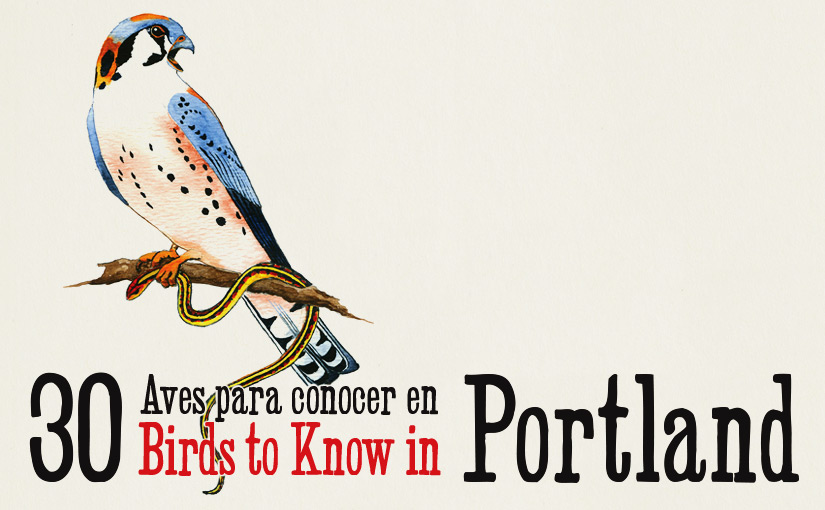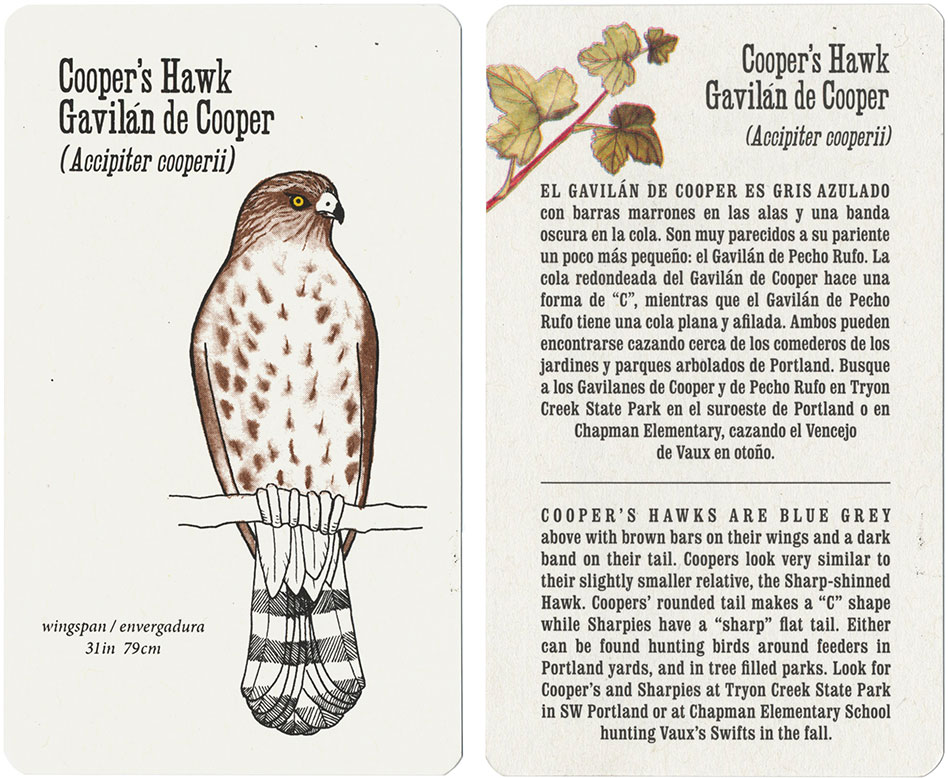
IRIS login | Reed College home Volume 96, No. 2: June 2017
Tackle Climate Change—Go Birdwatching
Bald eagles. Great Blue Herons. Mallard ducklings.
Anyone who has taken a study break to walk the forested Reed Canyon trails looking for birds and wildlife knows that connecting with the natural environment creates a sense of belonging and stewardship. Getting city-dwellers into green spaces and urban forests is an effective way to create a culture of conservation. But environmental studies–history major Esther Forbyn ’16 found that some Portlanders, especially traditionally marginalized groups like low-income residents and recent immigrants, can feel excluded from these spaces. Not only are these members of the community missing out on the benefits of communing with nature, the conversation about solutions to environmental problems is lacking important voices.
For Esther, solving this problem is crucial for tackling huge problems like global warming and loss of biodiversity. She researched Portland ecology for her senior thesis, which she wrote with Prof. Josh Howe [environmental studies & history 2012–], focusing on the history of wild areas in Portland and Portlanders’ relationship with nature. But in addition to her scholarship, she saw an opportunity to take action by increasing access and inclusion through a new interest of hers: birdwatching.
Esther, a native Oregonian from a working-class background who began birding five years ago, created a simple but elegant solution to the problem of helping traditionally marginalized groups feel welcomed into wild spaces: she designed a deck of bilingual, illustrated flashcards called 30 Birds to Know in Portland/30 Aves Para Conocer en Portland. Then, she launched an outreach project to put these in the hands of Portlanders who would benefit from feeling invited and involved.“Birding has been a way that I connect to a wild place. I slow down, I listen, I look closely, and I start to invest in that space. I get excited when a certain species returns at a given time of year, like Yellow-rumped Warblers (Chipe de Rabadilla Amarilla) in Portland springtime,” she says.
She knew from her own experience that, although that birding is one of America’s fastest growing hobbies, there was not much material out there for a beginning birder. Field guides can be thick, with hundreds of species, and are often not specific enough to a geographic region to make it easy for newbies to identify the birds that they see every day. She wasn’t surprised when a US Fish and Wildlife survey revealed that despite 37 million bird watchers in America, few are low-income or under 34. And this is too bad, because birding is an excellent way to increase science literacy through learning about biodiversity, species identification, data collection, as well as enhancing the sort of connection with nature that conservationists know leads to an ecologically minded population. Further, apps and worldwide citizen-science databases such as eBird.org (organized through the Cornell Lab of Ornithology and the National Audubon Society) allow amateur birders to report and compile their data, which has been very useful to scientists.
“Real change comes from the bottom up,” Esther says, “and it's time for people who are serious about protecting the remaining wild places to start inviting people to the table that aren't so invested in the status quo. That means poor people, working class people, and people of color, undocumented people, people who speak Spanish, Russian and Vietnamese need to be included in the conversation, not just affluent white people. And the way that you get people to invest in the wild places around our city is to invite them to those places and show them why they matter.”
To develop her idea, Esther won a $5000 Reed College Mellon Environmental Studies Summer Experience Fellowship and entered the CleanTech challenge at PSU. This helped her form focus groups to fine-tune her ideas and research, soliciting and incorporating feedback from the very community members who she hoped would benefit from her bird cards. Esther’s project won the “People’s Choice” award at the CleanTech event and was featured in a documentary called Make it Green. The Reed College Mellon Grant also enabled her to produce 500 decks to distribute and donate.
It’s no surprise that these cards have proven popular. They feature beautiful, hand-illustrated line-and-watercolor images of birds, executed by Esther herself. The deck of 30 includes a variety of species common to Portland: many very easy to spot like a Steller’s Jay (Chara Crestada) or a House Sparrow (Gorrión Domestico), but also some prize finds like the Western Tanager (Tangara de Capucha Roja) or a Peregrine Falcon (Halcón Peregrino). The name of each bird is given in English and Spanish, along with information about the species, size, and where in Portland you are likely to find it: including our own Reed Canyon, Oaks Bottom, and Smith and Bybee Wetlands. For each deck purchased, Esther donates one. She distributes these at farmers markets, community events, and recently donated 70 decks to the bilingual event, Explorando el Columbia Slough, sponsored by the Columbia Slough Watershed Council.
Her work has caught the interest of several local groups such as the Audubon Society of Portland, Bark (a watchdog organization for Mt Hood National Forest), Friends of Nadaka/Columbia Slough Watershed Council, and the intercultural communication center People Places Things. With each of these organizations she is partnering on similar projects such as other language birding cards, a Mt. Hood coloring book, and multilingual interpretive signage for the Nadaka Nature Park in Gresham.
"Esther has a big vision for herself and for making the natural world more accessible to people in a very intimate way,” says Jim Labbe ’95, former Urban Conservationist for the Audubon Society of Portland, who is collaborating with Esther on a proposal to create a set of Russian language cards.
To buy Esther’s Spanish language cards, visit her website and look for more of her bilingual birding materials to come.
And next time you’re in the Reed Canyon, perhaps you’ll be able to determine whether that bright, blue bird sunning itself on the pathway is a Scrub Jay or a Steller’s Jay, or maybe even a Western Bluebird—which has not been seen in Reed’s neighborhood for many years.
Editor's note: Esther was recently featured on the Eyes on Conservation Podcast. Check it out and hear her talk in depth about her conservation work, social justice, birds, and community in Portland.
Tags: environmental studies, thesis, canyon





LATEST COMMENTS
steve-jobs-1976 I knew Steve Jobs when he was on the second floor of Quincy. (Fall...
Utnapishtim - 2 weeks ago
Prof. Mason Drukman [political science 1964–70] This is gold, pure gold. God bless, Prof. Drukman.
puredog - 1 month ago
virginia-davis-1965 Such a good friend & compatriot in the day of Satyricon...
czarchasm - 4 months ago
John Peara Baba 1990 John died of a broken heart from losing his mom and then his...
kodachrome - 7 months ago
Carol Sawyer 1962 Who wrote this obit? I'm writing something about Carol Sawyer...
MsLaurie Pepper - 8 months ago
William W. Wissman MAT 1969 ...and THREE sisters. Sabra, the oldest, Mary, the middle, and...
riclf - 10 months ago